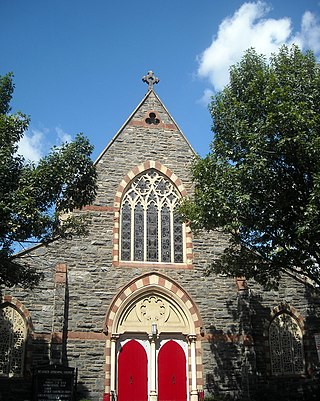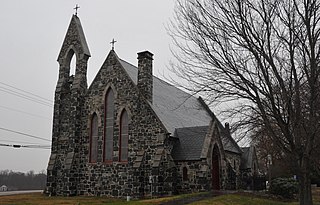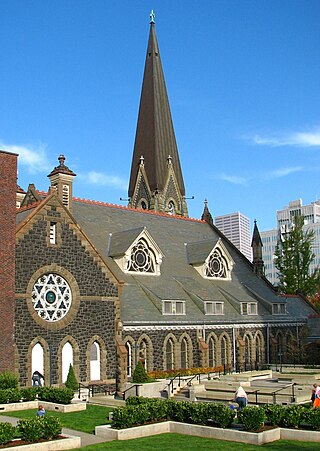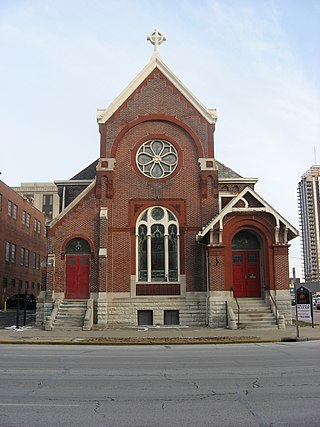
St. Luke's Episcopal Church is a historic Episcopal church located at 1514 15th Street, N.W., in Washington, D.C. Completed in 1879, it is home to the oldest African-American Episcopal congregation in the city. It was designated a U.S. National Historic Landmark in 1976 for its association with Rev. Alexander Crummell (1819–1898), a leading figure advocating black self-sufficiency and civil rights in the mid-19th century.

The Soul Harvest Ministries is located at 16300 Woodward Avenue in Highland Park, Michigan. It was built in 1916 as the First United Methodist Church and listed on the National Register of Historic Places in 1982.

Church of the Holy Trinity, or Holy Trinity Episcopal Church, is a historic Episcopal church located at Churchville, Harford County, Maryland. It is a stone structure built in 1878 in the Gothic Revival style. Its front facade features a triple window of stained glass, consisting of three Gothic-arched lancet windows It also features a steep roof, an architectural chancel at the east end, south porch and sacristy, belfry at the west end, and lancet windows and doors with pointed arches.

St. Andrew's Episcopal Chapel is an historic Episcopal chapel located at Sudlersville, Queen Anne's County, Maryland, built as a chapel of ease for St. Luke's Church in Church Hill. It was listed on the National Register of Historic Places in 1984.

The Oak Hill Cemetery Chapel, also known as the Renwick Chapel or James Renwick Chapel, is a historic building in the Georgetown neighborhood of Washington, D.C., United States. Designed by James Renwick, Jr. in 1850, Oak Hill Cemetery Chapel is the architect's only known example of Gothic Revival church architecture in Washington, D.C. It is located on the highest ridge in Oak Hill Cemetery, near the intersection of 29th and R Streets NW. The chapel is one of two structures in Oak Hill Cemetery listed on the National Register of Historic Places, the other being the Van Ness Mausoleum. The chapel, mausoleum, and cemetery are contributing properties to the Georgetown Historic District, a National Historic Landmark.

Grace Church or Grace Episcopal Church is a historic Episcopal church located at 600 Cleveland Avenue in Plainfield, Union County, New Jersey, United States. It was added to the National Register of Historic Places on May 10, 2002, for its significance in architecture, art, and music from 1892 to 1930.

Kilgore Union Presbyterian Church is a historic Presbyterian church building in Kilgore, Ohio.

Gethsemane Lutheran Church is a historic Lutheran church in downtown Austin, Texas. Designated as a Recorded Texas Historic Landmark and listed on the National Register of Historic Places, the building currently holds offices of the Texas Historical Commission.

Gaston Chapel is a historic African Methodist Episcopal church located at 100 Bouchelle Street in Morganton, Burke County, North Carolina. It was built from 1900 to 1911, and is a brick church building with a high-pitched hip roof and Late Gothic Revival style design influences. It features a Gothic-arched tripartite stained-glass window. It is the oldest extant, and first substantial, African-American church structure in Burke County.

Mt. Olive Baptist Church is a historic Baptist church located at 301 Church Street in Mullins, Marion County, South Carolina. It was built between 1922 and 1926, and is a one-story, Late Gothic Revival style brick cruciform building. It has a complex hip and gable roof and features twin corner towers of unequal height, a stained glass oculus above each entrance at the second level, a belfry containing four large pointed arch openings, and a large tripartite Gothic-arched leaded stained glass window flanked by stained glass lancet windows. The church played a major role in the African-American community in Mullins.

Williams Chapel A.M.E. Church is a historic African Methodist Episcopal church located at 1198 Glover Street in Orangeburg, Orangeburg County, South Carolina. It was built between 1915 and 1925, and is a one-story, brick Gothic Revival-style church building on a raised basement. It features two towers on the facade with pyramidal roofs and Gothic arched stained glass windows.

The First Presbyterian Church is a church building located in downtown Portland, Oregon, that is listed on the National Register of Historic Places. Construction began in 1886 and was completed in 1890. The building has been called "one of the finest examples" of High Victorian Gothic architecture in the state of Oregon. It includes stained-glass windows made by Portland's Povey Brothers Art Glass Works and a church bell cast with bronze from captured Civil War cannons.

St. Peter the Apostle Catholic Church and Rectory is a historic Roman Catholic church and rectory located at 812 Pearl Street in Joplin, Jasper County, Missouri. The church was built in 1906, and is a Late Gothic Revival style building constructed of Carthage limestone. It measures 63 feet, 6 inches, by 122 feet, 8 inches and features circular windows; tracery; Gothic arched windows and doors; and the triple portal entry. The rectory was built in 1917, and is a two-story Prairie School style dwelling with a finished basement. It is constructed of Carthage limestone and has a low pitched, hipped roof with wide overhang. Also on the property is a contributing concrete block garage.

Corinne Methodist Episcopal Church is a historic church at the corner of Colorado and S. 600 Streets in Corinne, Utah. It was one of the first churches in Corrinne, a town established by non-Mormons in the overwhelmingly Mormon Utah Territory. It was the first Protestant building in Utah as well as the first Methodist church in Utah. The church was completed in 1870, and was part of efforts by main-line Protestants to convert Mormons.

Saint Paul's Methodist Episcopal Church is a historic Methodist church building at 1327 Leighton Avenue in Anniston, Alabama. It was built in 1888 and added to the National Register in 1985.

The St. Michael's Episcopal Church in Anaheim, California, also known as The Chapel at St. Michael's Episcopal Church, is a historic church at 311 West South Street. It was built in 1876 and was added to the National Register of Historic Places in 2004.

Allen Chapel African Methodist Episcopal Church is an African Methodist Episcopal (AME) church located at 902 Broadway in Lincoln, Illinois. The church was built in 1880 to house Lincoln's African Methodist Episcopal congregation, which formed in 1868. The building has a vernacular design with Gothic arched windows and entrances. As a black church, Allen Chapel served as a center of Lincoln's small African-American community. The church hosted the community's religious and social events, and as an AME church it provided AME publications to and helped educate its members. As Lincoln was both segregated and predominantly white for much of the church's early history, the church played an important role as one of the few organizations dedicated to improving the lives of the city's black residents. The church is still used for religious services.

The Randolph Street Church of Christ is a historic church in Huntsville, Alabama. It was built in 1887 in a Gothic Revival style similar to rural churches, but built of brick. Rather than a central entrance, the tower contains doors under pointed toplights on the sides, and a double lancet window joined under a pointed arch. Another set of lancets flanks the tower. On the corners of the façade and along the side walls are pilasters, dividing the sides into bays with one set of lancets each. The eaves of the gable are corbelled. Above the eaves, the tower is faced with tin, and each side has a pair of arched vents below a small gable. A modern spire and weather vane top the tower. The church sits half a block from Courthouse Square, adjacent to the rear of the Milligan Block. The church was listed on the National Register of Historic Places in 1980.

Mount Pisgah Lutheran Church, also known in its early years as the First Lutheran Church and First English Lutheran Church and more recently as The Sanctuary on Penn, is located at 701 North Pennsylvania Street in downtown Indianapolis, Indiana. The historic church was built by the city's first Lutheran congregation, which organized in 1837, and was its third house of worship. The former church, whose present-day name is The Sanctuary on Penn, is operated as a for-profit event venue.

All Saints' Episcopal Church is a historic Episcopal parish church in Austin, Texas, United States. Built in 1899 on the edge of the University of Texas at Austin campus, the church has long-standing connections with the university's student body and faculty. The chapel was a project of Episcopal Bishop George Herbert Kinsolving, whose crypt is located under the church. It has been designated as a City of Austin Historic Landmark since 1980 and a Recorded Texas Historic Landmark since 2014, and it was listed on the National Register of Historic Places in 2015.






















